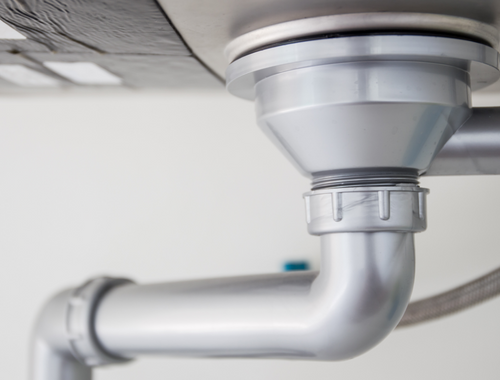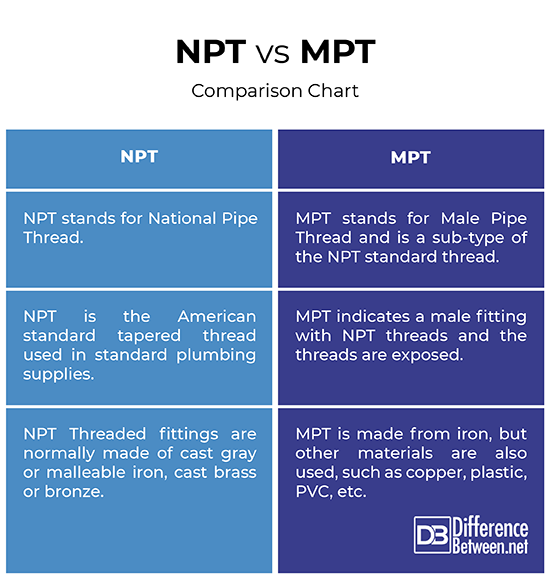Difference Between NPT and MPT
Fittings are probably amongst the most important components in plumbing that allow pipes to be joined together, change direction, or connect to fixtures. There are fittings for each kind of pipe and tubing made of the same material, sizes and thickness. The most important factor is to make sure the diameter and thread of the pipe should be same as the diameter and thread of the fitting. Most metal pipe and fittings you’ll find at the hardware store have the standard thread profile of the National Pipe Thread (NPT). In addition, NPT threads come in Female Pipe Thread (FPT) and Male Pipe Thread (MPT). MPT is basically a subtype of the NPT.

NPT
National Pipe Taper (NPT) thread is the US standard for tapered threads on pipes and fittings. It is the standard for threads of malleable iron pipe which has a slight taper. As the name suggests, it is a taper thread rather than a parallel thread you’d find on a BSP thread. Male NPT threads are referred to as MPT or MNTP and female NPT threads are called FPT or FNTP threads. In FTP, tapered threads are on the interior of a fitting whereas in MTP, tapered threads are on the exterior of a fitting. It is also known as ANSI/ASME B1.20.1 pipe threads. NPT is the most common pipe thread found on standard plumbing supplies. For a perfect seal, tapered threads must be wrapped with pipe thread tape.

MPT
Male Pipe Taper thread or MPT is a sub-type of the NPT thread which indicates a male fitting with NPT threads. A pipe with an MPT thread will fit an FPT (Female Pipe Thread) fitting. MPT is a name to identify the type of pipe thread for a specific application. MIP stands for Male Iron Pipe and like MPT, refers to a male fitting with a NPT thread. MPT threads come in all types of materials and sizes. Fittings may have only threaded sockets or outlets (sometimes called adapters). Unlike female pipe threads that have internal threads, MPTs have exposed threads.
Difference between NPT and MPT
Type
– NPT stands for National Pipe Thread or sometimes called National Pipe Taper Thread. NPT is the American standard tapered thread also known as ANSI/ASME B1.20.1 pipe threads. As opposed to a straight thread, NPT is slightly tapered and is the most common pipe thread found on standard plumbing supplies. MPT stands for Male Pipe Thread, or MPT, is a sub-type of the NPT thread which indicates a male fitting with NPT threads. Male threads are on the outside of the fitting or pipe.
Material
– NPT threads are the common standard for tapered threads in the US and are predominantly made from plastic and PVC. Adding threads to a pipe is done using a tool called a die, which cuts into the metal as you spin it. MPT threads come in all types of materials and sizes. Fittings may have only threaded sockets or outlets (sometimes called adapters). MPT, as the name suggests, is made from iron, but other materials are also used, such as copper, plastic, PVC, etc. Plastic is used less often because they are less durable.
NPT vs. MPT: Comparison Chart

Summary
In a nutshell, NPT stands for National Pipe Thread and is the American standard type of thread used in plumbing applications for over 100 years. NPT comes in MPT and FPT thread types. Male fittings with NPT threads are called MPT (Male Pipe Thread) and female fittings with NPT threads are referred to as FPT (Female Pipe Thread). Male and female connectors may be denoted as MIP (Male Iron Pipe) and FIP (Female Iron Pipe) respectively. NPT is just a genetic term for the same pipe thread. MPT is just a name used for identifying the type of pipe thread needed for a specific application purpose.
Does MPT fit NPT?
NPT is a generic term for the same pipe thread. MPT is a sub-type of the NPT thread and is interchangeable with NPT.
What is the difference between NPT and BPT?
BPT stands for British Standard Pipe Thread and the thread flank angle for both tapered and parallel threads is 55 degree. NPT has a 60-degree threadform.
What is the difference between NPT and MIP?
MIP is a pipe fitting with NPT threads and refers to fittings with male threads. MIP stands for Male Iron Pipe and it connects to the female thread. NPT is angled whereas MIP is straight.
What is the difference between NPT and NPS?
NPT threads are cut at an angle of 60 degrees whereas NPS threads are cut at an angle of 55 degrees.
What are the 3 basic types of threads?
The three common standards for threaded fittings can be US, British and metric. Within each standard, there are tapered or parallel (straight) threads.
Can I use NPT on NPS?
Both have the same thread angle, shape and pitch, so they will engage but will not seal properly.
How do I know if thread is NPT?
NPT threads have flattened peaks and valleys, and have a 60-degree included angle. NPT threads, as the name suggest, are tapered.
What is NPS thread used for?
National Pipe Straight (NPS) thread has the same thread angle, shape and pitch as the NPT threads. NPS fittings eliminate hose stress from twisting during assembly.
- Difference Between Caucus and Primary - June 18, 2024
- Difference Between PPO and POS - May 30, 2024
- Difference Between RFID and NFC - May 28, 2024
Search DifferenceBetween.net :
 Email This Post
: If you like this article or our site. Please spread the word. Share it with your friends/family.
Email This Post
: If you like this article or our site. Please spread the word. Share it with your friends/family.
Leave a Response
References :
[0]Bunker, Jordan. PVC and Pipe Engineer: Put Together Cool, Easy, Maker-Friendly Stuff. Massachusetts, United States: Rockport Publishers, 2017. Print
[1]Hart, Eric. The Prop Effects Guidebook: Lights, Motion, Sound, and Magic. Abingdon, London: Routledge, 2017. Print
[2]Siegenthaler, John. Heating with Renewable Energy. Massachusetts, United States: Cengage, 2016. Print

